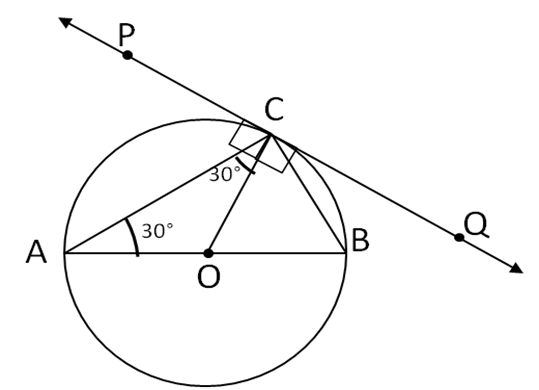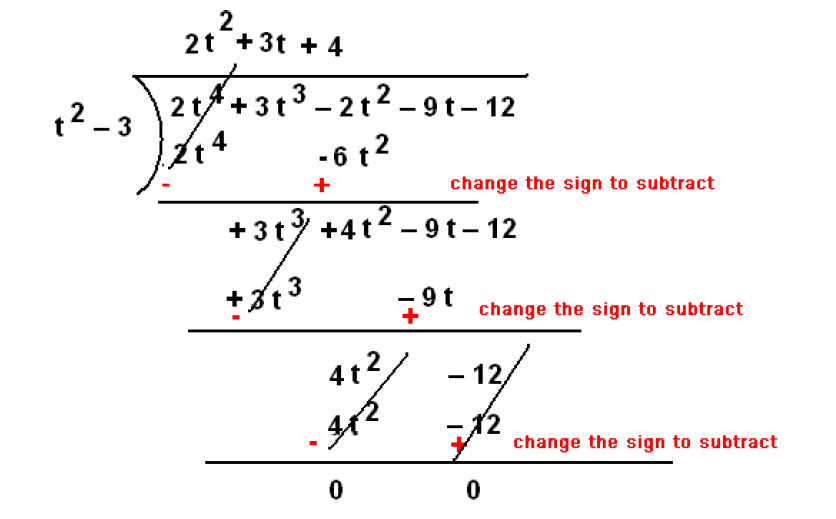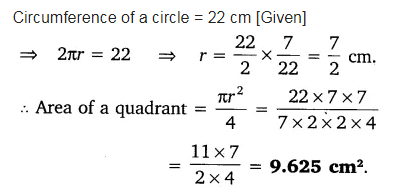Ask questions which are clear, concise and easy to understand.
Ask QuestionPosted by Charvi Sangwan 4 years, 11 months ago
- 2 answers
Yogita Ingle 4 years, 11 months ago
a1/a2 = 1/2
b1/b2= 2/4 = 1/2
c1/c2 = 5/1
No solution as a1/a2 = b1/b2 but not equal to c1/c2 so no solution to the above system of equation.
Posted by Pulkit Kumawat 4 years, 6 months ago
- 1 answers
Sia ? 4 years, 6 months ago
Pythagoras of Samos was an ancient Ionian Greek philosopher and the eponymous founder of Pythagoreanism. His political and religious teachings were well known in Magna Graecia and influenced the philosophies of Plato, Aristotle, and, through them, Western philosophy.
Posted by Sumit Rathi 4 years, 11 months ago
- 1 answers
Yogita Ingle 4 years, 11 months ago
0.7 bar means 0.77777777...
Let
x = 0.777......... ----(I)
10x = 7.77........ ----(II)
Subtract (II) from (I)
- 10x - x = 7.777.... + 0.777...
- 9x = 7
- x = 7/9
0.7 bar can be expressed as 7/9
Posted by Himanshi Mathur 4 years, 11 months ago
- 1 answers
Yogita Ingle 4 years, 11 months ago
let 4+ 5√3 be a rational number.
4 + 5√3= a/b where a and b are co primes
5√3=a/b-4
5√3=a-4b/b
a-4b/b- 5=√3
But this contradiction is wrong therefore 4+5√3 is a irrational number.
Posted by Nigarish ☺ 4 years, 11 months ago
- 0 answers
Posted by Manila Mehandiratta 4 years, 11 months ago
- 1 answers
Sonukishore Kamat 4 years, 11 months ago
Posted by Krazy Girl 4 years, 11 months ago
- 2 answers
Posted by Subash Gouda 4 years, 11 months ago
- 1 answers
Gaurav Seth 4 years, 11 months ago
In the given figure,

In Δ ACO,
OA=OC (Radii of the same circle)
Therefore,
ΔACO is an isosceles triangle.
∠CAB = 30° (Given)
∠CAO = ∠ACO = 30° (angles opposite to equal sides of an isosceles triangle are equal)
∠PCO = 90° …(radius is drawn at the point of
contact is perpendicular to the tangent)
Now ∠PCA = ∠PCO – ∠CAO
Therefore,
∠PCA = 90° – 30° = 60°
Posted by Nikhil Sidar 4 years, 11 months ago
- 1 answers
Gaurav Seth 4 years, 11 months ago
Suresh is having a garden near Delhi. In the garden, there are different types of trees and flower plants. One day due to heavy rain and storm one of the trees got broken as shown in the figure.The height of the unbroken part is 15 m and the broken part of the tree has fallen at 20 m away from the base of the tree.
Using the Pythagoras answer the following questions:
1) What is the length of the broken part?
A) 15 m
B) 20 m
C) 25 m
D) 30 m
2) What was the height of the full tree?
A) 40 m
B) 50 m
C) 35 m
D) 30 m
3) In the formed right-angle triangle what is the length of the hypotenuse?
A) 15 m
B) 20 m
C) 25 m
D) 30m
4) What is the area of the formed right angle triangle?
A) 100 m2
B) 200 m2
C) 60 m2
D) 150 m2
5 )What is the perimeter of the formed triangle?
A) 60 m
B) 50 m
C) 45 m
D) 100 m
Answer:
1)C
2)A
3)C
4)D
5)A
Posted by Hanan Ap 4 years, 11 months ago
- 2 answers
Yashita Bisht 4 years, 11 months ago
Posted by Deep ? Khushboo ? 4 years, 11 months ago
- 1 answers
Gaurav Seth 4 years, 11 months ago
Let AC be the ladder of length 5 m and BC = 4 m be the height of the wall, which ladder is placed. If the foot of the ladder is moved 1.6 m towards the wall i.e, AD = 1.6 m, then the ladder is slide upward i.e. ,CE = x m.
In right angled ΔABC,
Hence, the top of the ladder would slide upwards on the wall at distance 0.8 m.
Posted by Rahul Sethy 4 years, 11 months ago
- 4 answers
Yogita Ingle 4 years, 11 months ago

Remainder is 0 hence t² -3 is a factor of 2t4 + 3t³ – 2t² – 9t – 12
Posted by Account Deleted 4 years, 11 months ago
- 1 answers
Meenakshi Kashyap 4 years, 11 months ago
Posted by Utkarsh Vaibhav 4 years, 11 months ago
- 2 answers
Gaurav Seth 4 years, 11 months ago
Comparing f(x) = 4x2 - 8kx - 9 with ax2+bx+c we get
a=4; b=-8k and c=-9.
Since one root is the negative of the other, let us assume that the roots are p an -p.
Sum of the roots, a+(-a)=-b/a= - (-8k) / 4
0=2k
k=0
Posted by Pihu ✨ 4 years, 11 months ago
- 2 answers
Gaurav Seth 4 years, 11 months ago
A n s w e r
The value of 9sec²A-9tan²A =9
Step-by-step explanation:
The value of 9sec²A-9tan²A
= 9(sec²A-tan²A)
/* By Trigonometric identity:
= 9 ×1
= 9
Therefore,.
The value of 9sec²A-9tan²A =9
Posted by Naina Choudhary. 4 years, 11 months ago
- 3 answers
Yogita Ingle 4 years, 11 months ago
The elimination method is used to solve linear equations in two variables, where one of the variables is removed or eliminated. This method is sometimes more comfortable and convenient than the substitution method. Here are the notes provided with the complete steps to solve such linear equations where two variables are used.
In another classification, there are three different algebraic methods to solve simultaneous linear equations. These methods are namely:
- Substitution method
- Elimination method
- Cross-multiplication method
There are many situations which can be mathematically described by two equations that are not in the linear form. But we alter them so that they are reduced to a pair of linear equations. In this article, you will learn how to solve linear equations using the elimination method.
Posted by Naina Choudhary. 4 years, 11 months ago
- 1 answers
Yogita Ingle 4 years, 11 months ago
The substitution method is the algebraic method to solve simultaneous linear equations. As the word says, in this method, the value of one variable from one equation is substituted in the other equation. In this way, a pair of the linear equation gets transformed into one linear equation with only one variable, which can then easily be solved. Before moving to solve the linear equations using the substitution method, get an idea on what the algebraic method and graphical method is.
Posted by Mosaiyab Mosaiyab 4 years, 11 months ago
- 2 answers
Posted by Aryan Tiwari 4 years, 11 months ago
- 2 answers
Nikhil Dahiya 4 years, 11 months ago
Posted by Navjot Kaur 4 years, 11 months ago
- 3 answers
Yogita Ingle 4 years, 11 months ago
Let A(2, 0), B(9, 1), C(11, 6) and D(4, 4) be the given points. Coordinates of midpoint AC are
Coordinates of midpoint BD are
Since, coordinates of mid-point of AC ≠ coordinates of mid-point of . BD So, ABCD, is not a parallelogram. Hence, it is not a rhombus.
Posted by Vidhi Miglani 4 years, 11 months ago
- 1 answers
Gaurav Seth 4 years, 11 months ago
From the GIVEN FIGURE, we have
AB = 18 cm , DC = 32 cm , Distance between AB and DC(h) = 14 cm & radius of each circle(r) = 7cm
Since , AB ||DC
Therefore , ∠A + ∠D = 180° & ∠B + ∠C = 180°
[CO INTERIOR ANGLES are supplementary]
Area of sector = (θ /360) ×πr²
Area of sector with ∠A & ∠D = (180 /360) × 22/7 × 7²
= ½ × 22 × 7 = 11 × 7 = 77 cm²
Similarly, Area of sector with ∠B & ∠C = (180 /360) × 22/7 × 7²
= ½ × 22 × 7 = 11 × 7 = 77 cm²
Area of trapezium = ½ (sum of parallel sides) ×distance between Parallel sides(h)
Area of trapezium = ½ (AB + DC ) ×(h)
Area of trapezium = ½(18+32)×14
= ½(50)× 14 = 25 × 14 = 350 cm².
Area of shaded region = Area of trapezium - (Area of sector with ∠A & ∠D + Area of sector with ∠B & ∠C)
= 350 -(77+77) = 350 - 154 = 196 cm²
Area of shaded region = 196 cm²
Posted by Account Deleted 4 years, 11 months ago
- 5 answers
Posted by Account Deleted 4 years, 11 months ago
- 1 answers
Vani Tripathi 4 years, 11 months ago
Posted by Account Deleted 4 years, 11 months ago
- 1 answers
Nalshatra Singh Rajawat 4 years, 11 months ago
Posted by Account Deleted 2 years, 6 months ago
- 0 answers
Posted by Phalguni Gujar 4 years, 11 months ago
- 1 answers
??Vaishnavi Pandit?? 4 years, 11 months ago

myCBSEguide
Trusted by 1 Crore+ Students

Test Generator
Create papers online. It's FREE.

CUET Mock Tests
75,000+ questions to practice only on myCBSEguide app
 myCBSEguide
myCBSEguide

Himanshu Yadav 4 years, 11 months ago
0Thank You